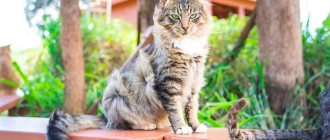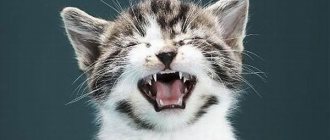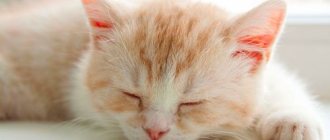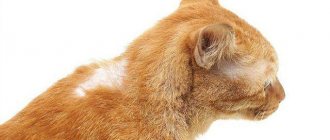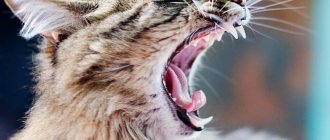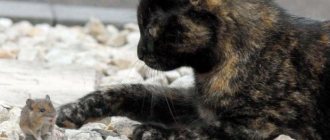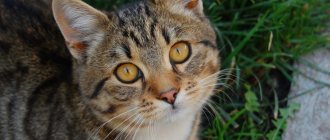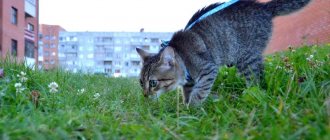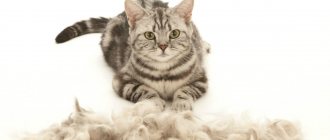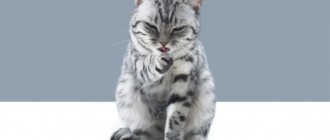Blood circulation and breathing of cats
The cat's circulatory system includes, just like a human's, a four-chambered heart and arteries that carry blood to the capillaries.
And also veins that deliver blood back to the heart. The respiratory system consists of the lungs and bronchi. The heart, a hardworking organ, works throughout life, pumping 475 liters of blood per day; it beats at a frequency of 110-160 beats per minute. Although its mass is small, it is only 16-32 g if the cat weighs 4 kg. This amounts to 0.4-0.8% of the total weight.
The blood performs its normal function: it delivers oxygen to the organs, supplies them with nutrients, and takes away waste products and carbon dioxide. All this happens in the systemic and pulmonary circulation. Through the arteries of the lungs from the right ventricle of the heart, blood passes through a small circle, becoming saturated with carbon dioxide and entering the lungs.
After gas exchange in the lungs (carbon dioxide is replaced by oxygen), the blood is sent to the left ventricle of the heart, from where it is released under pressure into the systemic circulation, reaching the smallest capillaries. Once again enriched with CO2, the blood returns through the veins to the heart, to the right ventricle, and the process begins again.
Cats have a normal body temperature of 38 C (oriental breeds and sphinxes have a higher temperature), three blood groups: A, B and AB. The composition is the same as in humans: blood serum, white and red blood cells, platelets responsible for blood clotting.
A cat breathes through the trachea, bronchi and lungs, where air enters through the larynx from the nose and mouth. A cat’s vocal cords are designed in such a way that it is here, in the larynx, that her affectionate purring, so beloved by us, arises. The lungs are alveoli (pulmonary vesicles) surrounded by a network of thin capillaries. The air enters the lungs warmed in the mucous membranes of the respiratory tract and cleared of dust. This is helped by the cilia of the ciliated epithelium, which line the respiratory tract.
Cat blood types
Are our favorites of the same blood?
Blood, which carries life to every cell of a living organism, has always been perceived as a magical or sacred liquid. Ancient healers attributed miraculous properties to it and tried to use the blood of both humans and animals for medicinal purposes. In ancient magical rituals, some of which are still performed today, animal blood was used for sacrifices.
Not only magicians, but also scientists tried to study and use blood for treatment several centuries ago. But only in the last century were truly great successes achieved in this direction. Blood transfusion, widely used in medicine, is one such achievement.
Human blood has already been studied quite deeply, but new discoveries are constantly being made in this direction. The same cannot be said about animals: it was only in the middle of the last century that the presence of different blood groups in dogs and cats was established. But extensive research, especially in our country, has not yet been carried out.
What is your cat's blood type?
Many breeders and even veterinarians do not know that cats can have one of three blood types - A, B and a mixed version of AB. The most in-depth research is carried out by American scientists. According to their observations, blood group A is much more common, group B is less common, and the mixed type AB is practically not registered.
The vast majority of outbred cats and cats have blood type A.
Among breed purrs, animals with group A also predominate. The distribution of representatives of felines with blood group B varies widely - from 5% to 50%, depending on the breed. For example, among most representatives of short-haired cat breeds, the percentage of animals with group B is insignificant.
Up to 25% of representatives of the Kuril Bobtail, Persian, Somali, Abyssinian and Scottish cats have blood type B. In representatives of the Cornish Rex and exotic breeds, blood type B is found in 50% of cases.
Why do you need to know your cat's blood type?
At first glance, studying and establishing the blood type in cats may be of mainly purely scientific interest. Cases in veterinary practice when it is necessary to make a transfusion from one animal to another do not occur often, especially when treating feline pets. But even if such a need arises, it is enough to do an analysis of the compatibility of the donor blood with the blood of the animal to which it will be transfused.
But many breeders and veterinarians, unfortunately, know of cases of kitten death in the first days after birth - “ anemic kitten syndrome ”. Strong kittens are born from healthy parents, but they die for unknown reasons within literally 1-4 days. Most often, they draw conclusions about insufficient immunity and simply begin to intensively feed the cat and cat with vitamin preparations before the next mating.
But even when the same pair of animals is re-mated, the kittens die. If there are viable kittens among the litter, then among them there is a large percentage of those who begin to experience necrosis of the last caudal vertebrae. Moreover, the same cat, after mating with another cat, can produce healthy, viable offspring. A cat can also become the father of healthy kittens, but for another cat. And all attempts to get offspring from this couple end in anemic kitten syndrome.
What is the cause of anemic kitten syndrome?
The fact is that parents have different blood groups - for example, A for a cat and B for a cat.
Kittens inherit their father's blood type and after birth they receive antibodies from their mother's milk that fight blood that is foreign to the cat. And the result of such a “bloody battle” is the death of kittens. There are only two ways to help preserve offspring born from a cat and a cat with different blood groups:
- or find a nurse for the kittens;
- or immediately after birth transfer them to artificial feeding.
Mating Features
Are you getting a cat for further breeding purposes? Then it will be useful to learn about all the nuances that precede the appearance of offspring. In large and small breeds, the age at which the first heat occurs varies slightly from 6 to 10 months
But it is important to remember that by this time the female’s body is not yet ready to bear cubs
At one year and three months, cats become ready to bear healthy offspring. Like most other representatives of the fauna, mating occurs when the cat develops sexual desire. This is a short period of time, and is preceded by long courtship on the part of the cat.
At the moment of arousal, the female does not resist during mounting and coitus (mating). During conception, the cat clings to the female with its claws and grabs the withers with its teeth. All this happens in complete privacy so that people do not see.
During a normal pregnancy, a cat carries cubs for 7-8 weeks. Wild individuals have kittens once a year, but domestic ones can have more. On average, one litter is 6 kittens, but when a cat gives birth to kittens for the first time, in the vast majority of cases no more than two kittens appear.
Digestive system of a cat
The digestive system of cats is the same as that of all mammals. With the help of its organs, food enters the body, is digested, and nutrients are absorbed. First, food enters the mouth, where it is crushed by teeth and powerful jaws. A cat's teeth perform different functions: the fangs serve as a defensive weapon and for catching prey, and small incisors for stripping meat from bones. It is noteworthy that cats do not chew food, but only crack it with sharp molars. Here, in the mouth, the digestion process begins with the help of saliva.
The cat's tongue is involved in the absorption of food and is an object for cleaning the fur, since it is covered with horny scales convenient for this. From the oral cavity, food is directed through the muscular esophagus into the single-chamber stomach. The esophagus has the ability to move food in two directions. This is important for cats because fur, bones and indigestible food particles end up in their stomachs. And vomiting, performing the cat’s self-preservation function, cleanses the stomach.
The digestion process occurs in the stomach under the influence of secretions secreted by its mucous membrane. From the stomach, food passes into the small intestine, where digestion continues with the help of an entire “chemical laboratory”. This includes gastric juice with the enzymes necessary for digestion, and bile (produced in the liver and secreted from the gallbladder through the bile ducts), which helps break down fats. Pancreatic juice is also secreted here, which carries substances that digest all components of food: fats, carbohydrates and proteins. With the help of all these important components, food is prepared for absorption into the blood through the intestinal walls, and the circulatory system delivers the resulting nutrients to all organs.
The length of the small intestine in a cat exceeds the length of the body by 3-4 times and is equal to 1-1.8 m; it is significantly shorter than that of vegetarian mammals (they have an intestinal length of 20-42 m), since the cat is a predator that eats meat.
The large intestine is a continuation of the small intestine. Solid, unprocessed food remains enter it along with gland secretions and bacteria. The large intestine consists of the cecum (2-4 cm), rectum and colon (cats do not have an appendix). The rectum performs an excretory function, forms feces, and maintains conditions for the proliferation of bacteria necessary for the body. The anus is closed thanks to the double sphincter, and feces are retained in the intestines. The intestines are cleansed once or twice a day in small portions.
Video: How Cats See. What do cats see? Why does Cat's Eye burn in the dark?
As for brain volume, scientists have proven that the brain size of a thin forest cat is much larger than that of a well-fed domestic British cat. This fact is explained by the fact that brain volume is directly dependent on the animal’s mobility and the complexity of the musculoskeletal functions performed by the cat throughout its life.
But it cannot be said that a domestic cat’s brain is not developed or that it is stupid. Quite the contrary, any cat, be it a wild street cat or a spoiled domestic beauty, has a fairly well-developed brain, with its help the cat is able to make decisions and compare almost with lightning speed.
You can also note the cat’s ability to move quickly, quickly and silently. Such skills are easily explained by the fact that the cat has a very unusual type of walking; it first moves its left paws, and then its right ones. Only cats, camels and giraffes are endowed with such an unusual gait.
Unlike all other animals and humans, cats have a different number of toes on their paws: there are four on the hind paws and five on the front paws. A large quarter of cats have the ability to use both their right and left paws equally. This gait gives the impression that the cat is walking on tiptoe. But that's not true. The cat's body weight is evenly distributed over the entire foot, but the cat still walks quietly and silently.
Everyone has probably noticed that cats have no smell. This is due to the fact that cats do not have sweat and fat glands on their bodies, except for the delicate pads on their paws. Very often, cat owners notice that after being examined by a veterinarian, wet marks from small cat paws remain on the table; this is sweat discharge. This biological feature causes cats a lot of trouble in the heat, so hot and dry weather, especially for British cats, is not the most pleasant time.
A cat is one of those animals on which nature has worked especially carefully. Few animals can boast such physical capabilities as a cat. Developing from a small kitten to an adult, a cat brings all its movements to automatism, these include acrobatic elements, fast running, incredible high and long jumps, climbing and crawling, instant coordination of all its movements, as well as instant reaction.
It is also necessary to pay special attention to the cat’s skeleton. It consists of 240 individual bones and 500 muscles
A cat's tail consists of 26 vertebrae. Most of the bones are connected to each other by cartilage tissue, and the remaining bones are connected by joints. And thanks to the veins, the cat can release or hide sharp claws in leather pouches that are located between the toes.
A cat's skin is covered with a dense network of muscles and blood vessels, which explains the fact that the cat is very sensitive to temperature changes and any touch. Also, cat skin is completely covered with a dense layer of hair.
Cats eyes
The love for night hunting in cats is caused by the peculiarities of the sensory organs and the structure of the eyes. The special arrangement of the eyes provides a field of view of 185 degrees. Both eyes look in the same direction, which makes vision three-dimensional, like in humans. And hunting at night is facilitated by the presence of a layer of reflective cells located behind the retina. The light is reflected from this shiny fabric and again enters the light perception zone.
The result is vision that is several times sharper than humans, although cats cannot see in complete darkness either. Under favorable circumstances, we can see the reflected light in the eyes of a cat at a distance of 80 m. We cannot compete with a cat in “night vision”.
It is believed that a cat can distinguish colors, but with less brightness and contrast.
A cat's pupil is special, formed by the iris, the name of which is of Greek origin - “ iris ”. The muscle fibers of the iris make it mobile, and it actively reacts to light. This ability is explained by its structure, which uses the principle of an automatic diaphragm; it transmits the required amount of light to the hypersensitive retina.
We can observe this process by seeing the pupil transform into a narrow vertical slit in bright light. With little light, the pupil becomes dark and takes on a round shape. If the cat’s pupils remain round in high light conditions, then we can assume some kind of disease or strong excitement from some external stimulus. Taking certain medications also works.
Cats' dexterity and good spatial orientation are explained by their ability to correctly estimate distances to objects. Cats perceive moving objects best. Being in absolute darkness, although a cat cannot see, it is not as helpless as a human. Acute hearing and touch are included in the work and help it.
Whiskers are also irreplaceable in such cases ; a cat has about twelve pairs of them. When a cat moves in the dark, the resulting air waves are reflected from objects. And with its whiskers, the cat senses the slightest vibrations in the air and does not bump into obstacles.
A cat's eyes have additional protection: a nictitating membrane. This so-called third eyelid protects the surface of the cornea from dust. It is almost invisible, it is hidden in the nasal corner of the eye, but it can stretch over the entire eye. And if the cat is sick, it may fall out. The color of the eyes depends on the intensity of the coloring substance - the pigment that colors the “iris”. It can be golden, greenish, blue, and in albinos - red, since they lack pigment and small vessels filled with blood give the eyes a red color.
External structure of a cat
The anatomical structure of a cat is incredibly organic and cannot but please the eye. Small size, cute face, soft paws, long flexible tail, fluffy fur - all this distinguishes cats from other animals. All parts of the body of these animals have their own charm and practical purpose, but at the same time they can hide certain secrets. For example, paws at first glance are completely harmless, but they hide the main weapon - the ability to release claws. Just like the cat itself, a seemingly affectionate pet, but at the same time a real predator.
Cat head
Eyes
The structure of a cat’s eye differs little from that of a human and a cat sees according to the same principle as we do – it reacts to light. The pupil tends to increase or decrease with the help of a special muscle, and its size depends on the amount of light. In the dark, a cat sees with the help of a special layer of the choroid - tapetum. It serves as a mirror that reflects the light received by the eyes, and due to this, vision is sharpened. The tapetum is also the reason why a cat's eyes glow in the dark.
Ears
The structure of a cat's ear allows it to detect more than 100 sounds, including ultrasonic sounds, with the help of which cats communicate with kittens. The auditory canals also contain an incredible number of nerve endings and more than 10 muscles. This is why cats can change the position of their ears on their heads - press them down, bend them, turn them towards the sound, etc.
Language
The structure of a cat's tongue is of some interest, primarily due to the fact that the animal manages to drink only with its help. The tongue is long, very flexible and, unlike, for example, a dog’s, very rough. The “sandpaper” effect occurs due to the keratinized papillae, which help retain food and also act as a kind of brush for cleaning the fur. In addition, the tongue performs a function that is familiar to us - recognizing the tastes of food. A cat can taste salty, bitter, sweet and sour.
Jaws and teeth
The structure of teeth in cats is of great importance, since teeth are one of the most important tools for hunting or, conversely, protection. An adult cat has 30 teeth, which are symmetrically located on the upper and lower jaw. The main tool for catching prey is 4 canines - these are the longest and sharpest teeth of a cat, 2 on each jaw on the sides of the incisors. With the help of incisors, cats tear off pieces of food, but cats' jaws are not adapted for chewing, so food begins to break down already in the oral cavity under the influence of saliva.
cat body
According to their build, cats are divided into three types: heavy, light and medium. The severe type is characterized by the presence of a large cat head on a short neck, a wide chest and rather short legs and tail. Lightweight - with a slender body, a long neck and a narrow head, as well as a long tail and paws. The medium type is somewhere between heavy and light, and most cats, especially non-pedigree cats, are of the medium type. But the appearance, weight and size of a cat does not depend on its build; there are both representatives of the heavy type, but small in size, and large slender cats.
Paws and claws
The structure of a cat's paw is especially curious because the claws can extend or retract. Cats have 5 toes on their front paws, but one is shortened and does not reach the ground. There are only 4 toes on the hind legs, the big one is missing. It is also noteworthy that the cat walks only on its toes, which, of course, contributes to noiseless movement. A cat's paws concentrate all the sweat glands and many nerve endings, so the cat can also receive information by touching an object with its paw.
The structure of the claw is unique; most breeds have crescent-shaped claws, with the exception of Persian cats with claws that are more reminiscent of hooks, which pose a particular danger when scratching, as they get under the skin.
Tail
The structure of a cat's tail is usually divided into 3 parts: the root, the stem (actually, the tail itself) and the tip. The root consists of 4-6 short and wide vertebrae, the stem of 10-15, which are cylindrical in shape, and at the tip there are 5-7 of the thinnest and smallest vertebrae, the very last of which may be undeveloped, often sharp. Between the vertebrae there are cartilages and joints, they provide the tail with flexibility and mobility. The tail can help a cat maintain balance, but its significance is more visual, and it is also one of the tools of the cat's language.
Smells and tastes
Cats' sense of smell
The sense of smell plays a significant role in the life of cats. In normal living conditions, animals often use their sense of smell; they are very susceptible to various odorous substances. Cats, while inferior to dogs in sense of smell, are much superior to humans in this. They have 60-80 million olfactory cells versus 5-20 million in humans.
Every day we observe the use of cats’ sense of smell in everyday life: searching for food, identifying “friends” and “strangers” by smell, relationships between animals. The cat is interested in almost all the smells that humans use, even perfume, not to mention the valerian beloved by these animals. She attracts, attracts and excites them. But there are also smells that cats don’t like and irritate them.
The odorous substance is secreted in cats by special glands located on the head. If a cat rubs its head against its owner or some object, it leaves its marks. Animals also mark their territory with urine. A pungent unpleasant odor lingers for a long time in the marked areas. When cats reproduce, smell also plays a role. During a cat's heat period, cats do not need to hear her inviting meow - they will find her by smell. A cat recognizes a dog, its potential enemy, from afar, also by smell. The world of smells in which cats live is, unfortunately, inaccessible to us.
Taste sensations
A cat distinguishes the taste of food with its taste buds on the tongue, this is evidenced by its pickiness in food. She prefers to eat only what she likes. Cats are gourmands and gourmets - not a novelty. You can hear from many owners about the incredible pickiness of their pets. You have to cook specially for them, spending time and effort, buying different products for your favorite and most delicious dishes. When you get a cat, you need to know about its preferences for gastronomy, but you still shouldn’t pamper it too much and fulfill its whims.
Sometimes you can observe how a cat, sniffing, suddenly raises its head, opening its mouth slightly, lifts its upper lip slightly and at the same time wrinkles its nose. In this way, it senses volatile substances using its vomeronasal olfactory organ, a method called flemen . At the same time, she sniffs marks left by other cats or any other strong-smelling substance.
A cat's sense of taste is closely related to its good sense of smell. Scientists have found that the acuity of taste and smell in cats is provided by an organ that has not yet been fully studied. This is a Jacobson's tube . It is located on the cat's upper jaw behind the front incisors and is a one-centimeter long tube. Perhaps you have noticed that when a cat sniffs, it lifts its upper lip. She probably does this so that the smell gets into the hole of this tube. Perhaps cats perceive tastes and smells that we are not even aware of.
Muscles, joints and tendons
The animal makes all its movements unconsciously thanks to the muscular system.
The presence of seal muscles includes smooth and striated muscles. Smooth muscles cover the internal organs. The work is carried out thanks to nerve impulses that come from the brain to the organ. Cats cannot control this process. Striated tissues are attached to the skeleton and carry out movement. Thanks to them, the neck, paws, and spine move. Attached to bones using tendons. Two bones meet in one place. At the joints they are connected by ligaments. The structure of the collarbone in cats is different from other animals. They are thin and not attached to the shoulder girdle. The collarbone moves freely without limiting the movement of the animal, which is why it is called “floating”. All of these structures work in harmony to enable the cat's graceful movements.
Puberty of cats
Many factors can influence a cat's puberty. These include the conditions of detention, the breed, and simply the individual characteristics of each animal. Therefore, the first heat can occur at five months, or maybe at 9-18 months, as, for example, in cats of large, long-haired breeds.
Seasons can also influence the onset of puberty. A cat born in the summer can mature in eight months, while a spring cat can mature in a year or more.
Characteristic signs of maturation in cats are the production of loud uterine sounds and the adoption of poses typical of mating. Cats also become loud at this time, sometimes they mark their territory.
But all these phenomena do not mean the complete physiological development of the cat’s body, and do not indicate its readiness to use it for reproduction. Physiological maturity occurs no earlier than 10-16 months (depending on the breed). It is at this age, after the second or third heat, that the cat can be coated.
Before this time, the cat can be prepared for an important mission and vaccinated. Her body will get stronger and take shape. After the onset of physiological maturity, a cat is able to produce healthy offspring for 5-6 years without compromising its health. And only after this time, with age, her litters will begin to decrease, as will the size of the kittens.
Periods of estrus correspond to cycles of sexual arousal; their duration is 6-8 days. And between heats there can be breaks of one or two weeks, or long ones - up to six months. Vaccinations must be done in advance, but it is not recommended to do this immediately before coating or even two weeks in advance.
We must remember that mating during the first heat can end unfavorably.
Cats, like all living beings, have deviations in physical development in one direction or another. In some breeds, especially eastern ones, signs of puberty appear very early, and regular estrus appears. Long-term non-covering of such cats threatens them with diseases: polycystic disease, exhaustion, disruption of the estrus cycle and hormonal abnormalities.
To avoid such problems, it is necessary to mate the cat, if possible earlier, but be sure to consult a doctor about the cat’s physiological readiness for pregnancy and raising offspring. Conditional recommendations for breeding for the third heat and by the age of one year lose all meaning; here it is worth acting in accordance with the opinion of veterinarians and breed specialists.
General information about the cat's body
Few people know, but these cute animals are weakly sensitive to electric current. So, in case of an accidental electric shock, death is unlikely. Some time after assistance is provided, your pet will revive and gradually come to its senses.
However, it is better not to conduct experiments and, if possible, to prevent such situations and not allow them under any circumstances. Nothing passes without a trace for the body. Complications and pathologies may occur in various body systems (nervous, cardiovascular).
Do not rush to run to the veterinary clinic if, after measuring your pet’s temperature, you see 38.70 C. In a healthy adult cat, temperature readings range from 38 to 39.5 C. In kittens, it can be even higher. But still, each individual organism is individual.
As with any other standard procedure, your pet should be accustomed to using a thermometer from childhood. This will allow you to find out the norm for your animal, which, having gotten used to the thermometer, will begin to calmly react to it in the future. This does not mean that you need to torture your cat every day. It is enough to do this regularly, especially in the off-season.
Pulse is also an important factor. Usually this is 100-120 beats/min.
There is no need to sound the alarm if your animal is breathing through its mouth. It thus regulates heat exchange. She's hot. At rest, the frequency of respiratory movements is 20-30, in young individuals - 40.
Video: Biological and physiological basis of feeding dogs and cats
Wool replaces her clothes. It is the fur that protects the cat from sunburn and overheating, and also protects the skin from damage. At the roots of the hairs there are muscles, thanks to which the hair can stand up. This happens when the cat is scared or aggressive.
Under the cat's fur there are also sebaceous glands that secrete liquid, and the cat simply rubs it into the hairs with its rough tongue, due to which the fur becomes silky. But this is not only for the cat’s beauty, but also for benefit. It is because of this greasy impregnation that cats do not get wet through heavy rain.
Attention, TODAY only!
Similar
Skeletal structure of a cat
The cat skeleton contains approximately 240 bones. It has an axial and peripheral part. The structure of the axial section includes:
- Scull. Its front and brain parts are almost equal in size. The facial part is formed from 13 bones. The dentition of adult animals consists of 30 teeth. In the jaw of a one-month-old kitten there are 26 milk units, which change to permanent ones by 6 months.
- Spine. Movable vertebrae make the cat very flexible. The most massive bones are located in the cervical region. The thoracic part consists of 13 vertebrae, to 12 of which ribs are attached on both sides. The lumbar part includes 7 bones; muscles that support organs located in the abdominal cavity are attached to them. The sacrum consists of 3 fused vertebrae, the tail - of 12–28 movable ones.
- Rib cage. The breast bone unites 8 pairs of ribs in the front of the body. The animal's collarbones are rudiments, so they are not developed. This makes it easier for the cat to move around and gives it the ability to get into narrow crevices.
The peripheral part of the skeleton is represented by two pairs of limbs. Cats have 5 toes on their front legs. Sharp downward curved claws grow on the outer phalanges of the fingers. The hind legs are longer than the front legs, and there are only 4 toes on each of them.
Brain and endocrine system
Anatomically, a cat's brain is similar to the brain of any mammal.
The structure of a cat's brain is similar to that of any mammal.
Different parts of the brain are responsible for one or another function in the body:
- the parietal lobe processes information received through the senses;
- the large brain is responsible for consciousness;
- the corpus callosum connects the right and left hemispheres;
- the frontal lobe is responsible for voluntary movements;
- the olfactory bulb is responsible for the perception of smells;
- the hypothalamus secretes hormones and controls the autonomic nervous system;
- the pituitary gland coordinates and controls the work of other glands;
- the spinal cord transmits information from the brain to the body;
- the pineal gland is responsible for sleep and wakefulness;
- the cerebellum controls movements and muscle function;
- the temporal lobe is responsible for behavior and memory;
- The occipital lobe receives visual and tactile signals.
The endocrine system influences the basic functions that occur in the body with the help of hormones. Most hormones are secreted by the pituitary gland and hypothalamus. Also some of them are produced by the thyroid gland, adrenal glands, ovaries in cats and testicles in cats.
The endocrine system influences the body's basic functions
Table: hormonal regulation of cat body functions
| Hormone name | Where is it produced? | Functions |
| Antidiuretic hormone (ADH) | Hypothalamus | Urine concentration |
| Oxytocin | Hypothalamus | Labor and feeding of kittens |
| Corticoliberin | Hypothalamus | Adrenocorticotropic hormone concentration |
| Adrenocorticotropic hormone (ACTH) | Hypothalamus | The adrenal glands produce cortisol when the cat is afraid |
| Thyroid-stimulating hormone (TSH) | Pituitary | Thyroid activity |
| Melanocyte-stimulating hormone (MSH) | Pituitary | Melatonin synthesis in the pineal gland |
| Follicle stimulating hormone (FSH) | Pituitary | Production of sex hormones and eggs in females |
| Luteinizing hormone (LH) | Pituitary | Production of sex hormones and sperm in males |
| Adrenalin | Adrenal glands | Cardiac activity and dilation of blood vessels |
| Progesterone | Ovaries | Preparing the uterus for implantation of embryos, maintaining pregnancy, stimulating the development of mammary glands |
| Testosterone | Testicles, adrenal glands | Development of the cat's reproductive system, development of secondary sexual characteristics |
| Thyroxine | Thyroid | Activation of metabolism, thickening of the uterine walls, increase in heart rate |
Acquired habits of cats
Not all cats allow their owner to pick them up. This habit needs to be gradually instilled in them. There are simple and effective recommendations on how to accustom a cat to being handled so that it is affectionate and friendly:
- Accustoming a pet to your hands should begin at the age of a kitten, because accustoming an adult cat is much more difficult;
- It’s better to do this gradually, first you need to talk affectionately to the furry pet, stroke it behind the ear, after which it can jump into your arms, do not grab it and hold it by force;
- A cat's weakness is tasty food, when the cat eats calmly, you can try to stroke it, and a well-fed cat falling asleep can allow itself to be taken on your lap.
And about one more acquired habit. Pet owners are interested in why cats respond to kitty cats, even those that live outside. It turns out that everything is very simple - it’s a matter of habit; they’ve heard this call since childhood. In other countries, cats do not respond to this form of calling. For example, in France, a cat is attracted by the call “minu-minu”, in the Czech Republic – “chi-chi”, in America – “kiri-kiri”, in Italy – “michu-michu”, and in Korea – “nabiya-nabiya”. Fortunately, cats from all over the world respond in the same native cat language.
The popularity of cats is explained by their beauty, cleanliness, grace, dexterity and playfulness. Moreover, each pet has different behavior, habits and disposition.
And no matter how cats try to show their independence, they urgently need the attention and affection of their owner, and if this is lacking, they suffer. The owner should show not only understanding, but also patience with the peculiarities of the cat’s behavior, and then the domestic cat will reward him with devotion and affection, and at the right moment, she will calm her down and lift her spirits. Read interesting facts about cats.
Urinary organs
Structure
. The urinary organs consist of the kidneys, which produce urine, and the urinary tract. From the renal pelvis, urine flows through the ureter into the bladder and accumulates here. The bladder has a closing muscle that prevents urine from spontaneously flowing into the urethra. In cats, the canal ends in the prevagina, and in cats, at the tip of the penis. It should be noted that the cat’s urethra has many physiological narrowings (stenoses), which facilitate the passage of sediment present in the urine.
Urine
. The daily urine rate for a cat is 100-200 milliliters (urination 2-4 times).
Urine serves to remove metabolic products, as well as foreign (toxic) substances that have entered the body. If they were not thrown away, they would have a harmful effect on the body. Urinary excretion also regulates salt and water metabolism in the body, maintaining it within physiological limits. As we already know, urine also serves to mark territory during the mating season and has a persistent, pervasive odor in cats.
